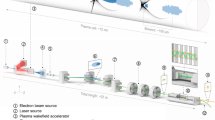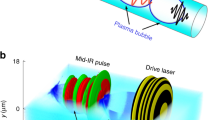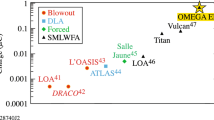Abstract
Laser–plasma acceleration1,2 is an emerging technique for accelerating electrons to high energies over very short distances. The accelerated electron bunches have femtosecond duration3,4, making them particularly relevant for applications such as ultrafast imaging5 or femtosecond X-ray generation6,7. Current laser–plasma accelerators deliver 100 MeV (refs 8–10) to GeV (refs 11, 12) electrons using Joule-class laser systems that are relatively large in scale and have low repetition rates, with a few shots per second at best. Nevertheless, extending laser–plasma acceleration to higher repetition rates would be extremely useful for applications requiring lower electron energy. Here, we use single-cycle laser pulses to drive high-quality MeV relativistic electron beams, thereby enabling kHz operation and dramatic downsizing of the laser system. Numerical simulations indicate that the electron bunches are only ∼1 fs long. We anticipate that the advent of these kHz femtosecond relativistic electron sources will pave the way to applications with wide impact, such as ultrafast electron diffraction in materials13,14 with an unprecedented sub-10 fs resolution15.
This is a preview of subscription content, access via your institution
Access options
Access Nature and 54 other Nature Portfolio journals
Get Nature+, our best-value online-access subscription
$29.99 / 30 days
cancel any time
Subscribe to this journal
Receive 12 print issues and online access
$209.00 per year
only $17.42 per issue
Buy this article
- Purchase on Springer Link
- Instant access to full article PDF
Prices may be subject to local taxes which are calculated during checkout



Similar content being viewed by others
References
Tajima, T. & Dawson, J. M. Laser electron accelerator. Phys. Rev. Lett. 43, 267–270 (1979).
Esarey, E., Schroeder, C. B. & Leemans, W. P. Physics of laser-driven plasma-based electron accelerators. Rev. Mod. Phys. 81, 1229–1285 (2009).
Lundh, O. et al. Few femtosecond, few kiloampere electron bunch produced by a laser–plasma accelerator. Nat. Phys. 7, 219–222 (2011).
Buck, A. et al. Real-time observation of laser-driven electron acceleration. Nat. Phys. 7, 543–548 (2011).
Miller, R. J. D. Femtosecond crystallography with ultrabright electrons and X-rays: capturing chemistry in action. Science 343, 1108–1116 (2014).
Corde, S. et al. Femtosecond X-rays from laser–plasma accelerators. Rev. Mod. Phys. 85, 0034–6861 (2013).
Ta Phuoc, K. et al. All-optical Compton gamma-ray source. Nat. Photon. 6, 308–311 (2012).
Faure, J. et al. A laser-plasma accelerator producing monoenergetic electron beams. Nature 431, 541–544 (2004).
Geddes, C. G. R. et al. High-quality electron beams from a laser wakefield accelerator using plasma-channel guiding. Nature 431, 538–541 (2004).
Mangles, S. P. D. et al. Monoenergetic beams of relativistic electrons from intense laser–plasma interactions. Nature 431, 535–538 (2004).
Wang, X. et al. Quasi-monoenergetic laser–plasma acceleration of electrons to 2 GeV. Nat. Commun. 4, 1988 (2013).
Leemans, W. P. et al. Multi-GeV electron beams from capillary-discharge-guided subpetawatt laser pulses in the self-trapping regime. Phys. Rev. Lett. 113, 245002 (2014).
Zewail, A. H. 4D ultrafast electron diffraction, crystallography, and microscopy. Annu. Rev. Phys. Chem. 57, 65–103 (2006).
Sciaini, G. & Miller, R. J. D. Femtosecond electron diffraction: heralding the era of atomically resolved dynamics. Rep. Prog. Phys. 74, 096101 (2011).
Faure, J. et al. Concept of a laser-plasma-based electron source for sub-10-fs electron diffraction. Phys. Rev. Accel. Beams 19, 021302 (2016).
Malka, V. et al. Electron acceleration by a wake field forced by an intense ultrashort laser pulse. Science 298, 1596–1600 (2002).
Böhle, F. et al. Compression of CEP-stable multi-mJ laser pulses down to 4 fs in long hollow fibers. Laser Phys. Lett. 11, 095401 (2014).
Jullien, A. et al. Carrier-envelope-phase stable, high-contrast, double chirped-pulse-amplification laser system. Opt. Lett. 39, 3774–3777 (2014).
He, Z.-H. et al. High repetition-rate wakefield electron source generated by few-millijoule, 30 femtosecond laser pulses on a density downramp. New J. Phys. 15, 053016 (2013).
Beaurepaire, B. et al. Effect of the laser wave front in a laser–plasma accelerator. Phys. Rev. X. 5, 031012 (2015).
Pukhov, A. & Meyer-ter-Vehn, J. Laser wake field acceleration: the highly non-linear broken-wave regime. Appl. Phys. B 74, 355–361 (2002).
Lu, W., Huang, C., Zhou, M., Mori, W. B. & Katsouleas, T. Nonlinear theory for relativistic plasma wakefields in the blowout regime. Phys. Rev. Lett. 96, 165002 (2006).
Lu, W. et al. Generating multi-GeV electron bunches using single stage laser wakefield acceleration in a 3D nonlinear regime. Phys. Rev. ST Accel. Beams 10, 061301 (2007).
He, Z.-H. et al. Electron diffraction using ultrafast electron bunches from a laser-wakefield accelerator at kHz repetition rate. Appl. Phys. Lett. 102, 064104 (2013b).
He, Z.-H. et al. Capturing structural dynamics in crystalline silicon using chirped electrons from a laser wakefield accelerator. Sci. Rep. 6, 36224 (2016).
Goers, A. J. et al. Multi-MeV electron acceleration by subterawatt laser pulses. Phys. Rev. Lett. 115, 194802 (2015).
Lifschitz, A. F. & Malka, V. Optical phase effects in electron wakefield acceleration using few-cycle laser pulses. New J. Phys. 14, 053045 (2012).
Beaurepaire, B., Lifschitz, A. & Faure, J. Electron acceleration in sub-relativistic wakefields driven by few-cycle laser pulses. New J. Phys. 16, 023023 (2014).
McGuffey, C. et al. Ionization induced trapping in a laser wakefield accelerator. Phys. Rev. Lett. 104, 025004 (2010).
Pak, A. et al. Injection and trapping of tunnel-ionized electrons into laser-produced wakes. Phys. Rev. Lett. 104, 025003 (2010).
Miranda, M. et al. Characterization of broadband few-cycle laser pulses with the d-scan technique. Opt. Express 20, 18732–18743 (2012).
Lifschitz, A. et al. Particle-in-cell modelling of laser–plasma interaction using Fourier decomposition. J. Comp. Phys. 228, 1803–1814 (2009).
Acknowledgements
The authors acknowledge the help of the support team at the Photo-Injector facility at Laboratoire de l'Accélérateur Linéaire for the absolute calibration of our phosphor screens. This work was funded by the European Research Council (ERC Starting Grant FEMTOELEC) under contract no. 306708. Financial support from the Région Ile-de-France (under contract SESAME-2012-ATTOLITE), the Agence Nationale pour la Recherche (under contracts ANR-11-EQPX-005-ATTOLAB and ANR-14-CE32-0011-03) and the Extreme Light Infrastructure-Hungary Non-Profit Ltd (under contract NLO3.6LOA) is gratefully acknowledged.
Author information
Authors and Affiliations
Contributions
A.V., B.B., D.Gué, D.Gus and J.F. built the laser–plasma experiment. D.Gué and D.Gus performed the experiment and analysed the data. F.B., M.B., M.L., A.J. and R.L.-M. developed the near-single-cycle laser system. A.L. performed the modelling of the experiment. J.F. and D.Gué wrote the paper with inputs from all co-authors. J.F. directed the project.
Corresponding author
Ethics declarations
Competing interests
The authors declare no competing financial interests.
Supplementary information
Supplementary information
Supplementary information (PDF 762 kb)
Rights and permissions
About this article
Cite this article
Guénot, D., Gustas, D., Vernier, A. et al. Relativistic electron beams driven by kHz single-cycle light pulses. Nature Photon 11, 293–296 (2017). https://doi.org/10.1038/nphoton.2017.46
Received:
Accepted:
Published:
Issue Date:
DOI: https://doi.org/10.1038/nphoton.2017.46
This article is cited by
-
Electro-optic 3D snapshot of a laser wakefield accelerated kilo-ampere electron bunch
Light: Science & Applications (2024)
-
Controlling the characteristics of injected and accelerated electron bunch in corrugated plasma channel by temporally asymmetric laser pulses
Scientific Reports (2022)
-
A focused very high energy electron beam for fractionated stereotactic radiotherapy
Scientific Reports (2021)
-
Multi-pass probing for high-sensitivity tomographic interferometry
Scientific Reports (2021)
-
Quasi-phase-matched laser wakefield acceleration of electrons in an axially density-modulated plasma channel
Scientific Reports (2021)



